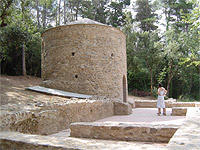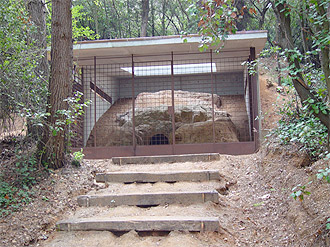La presente Política de Privacidad es aplicable al tratamiento de datos personales por parte deRESTAURANT MASIA CAN BORRELL SL (en adelante la “Empresa”)dentro de sus webs, app y cualquier otro medio electrónico o plataforma digital en las que la empresa trate datos personales.
1.- Responsable del tratamiento de los datos:
RESTAURANT MASIA CAN BORRELL SL with CIF B60885449 address Carretera de Horta a Cerdanyola (BV-1415), km 3. 08171 Sant Cugat del Valles (Barcelona) and email info@can-borrell.comis responsible for the processing of the data provided, we inform you that these data will be treated in accordance with the provisions of Regulation (EU) 2016/679 of the European Parliament and of the Council of 27 April 2016 on the protection of natural persons with regard to the processing of personal data and on the free movement of such data and Organic Law 3/2018 of 5 December on the Protection of Personal Data and Guarantees of Digital Rights.
2.- Legitimación del tratamiento de los datos:
The legitimacy for the processing of your data is the consent obtained from the user. Users, by checking the corresponding box, expressly, freely and unequivocally accept that their data is necessary for the provider to meet their request. The user guarantees that the personal data provided is true and is responsible for communicating any changes to them.
All data requested through the web service are mandatory, as they are necessary for the provision of the service. If not all the data is provided, there is no guarantee that the information and service provided by the provider will be fully tailored to your needs.
The legal basis for the processing of data is Regulation (EU) 2016/679 of the European Parliament and of the Council;
.- Obtaining data through the website’s contact forms; Art. 6.1 a) the interested party
has given consent to the processing of his or her personal data for one or more purposes
específicos;
.- Receiving commercial communications by checking the box for this purpose or
suscribiéndose al boletín de noticias; Art 6.1 a) el interesado dio su consentimiento para el
tratamiento de sus datos personales para uno o variosfines específicos;
.-Execution of a contract between the client and the Data Controller for the sale of
products or the provision of a service; Art. 6.1 b) processing is necessary for the performance of a
contract in which the interested party is a party to the application at the request of this of measures
precontractuales;
.- Invoicing for products sold or services provided to the customer; Art 6.1 c) the processing is
necessary for compliance with a legal obligation to which the controller is subject.
3.- Finalidad del Tratamiento:
The purpose is to maintain a commercial relationship with the user of the company’s websites, apps, and any other electronic media or digital platform. To carry out the processing, the planned operations are:
.- Process orders, requests or any type of request made by the user through any of the contact forms made available.
.- Sending commercial advertising communications related to our products and services by any electronic or physical means, present or future, that makes it possible to carry out commercial communications when the user has given their consent to do so.
.-If you provide us with your curriculum vitae or send us your CV, we will use your data to manage the contact and selection processes that we carry out.
4.- Conservación de los datos:
They will be kept as long as there is a mutual interest in maintaining the purpose of the treatment. When they are no longer necessary for that purpose, they will be deleted with appropriate security measures to guarantee their total destruction. The personal data provided by the interested party will be kept even if their deletion is requested by the same, limiting their treatment only for the fulfillment of legal obligations and/or the exercise or defense of claims.
5.- Cuáles son tus derechos cuando nos facilitas tus datos:
Al usuario le asisten los derechos de:
.- Derecho de Acceso, articulo 15 del RGPD.
.- Derecho de Rectificación, articulo 16 RGPD
.- Derecho de Supresión (Derecho al Olvido), articulo 17 RGPD.
.- Derecho a la Limitación del Tratamiento, articulo 18 RGPD.
.- Derecho a laPortabilidad de los datos, articulo 20 RGPD
.- Derecho de Oposición, articulo 21 RGPD.
Estos derechos son:
.- Saber si tratamos tus datos o no.
.- Acceder a los datos personales tuyos que disponemos.
.- A rectificar tus datos que no sean correctos.
.- Request the deletion of your data or withdraw the consent granted.
.- To request the limitation of the processing of your data, in which case they will only be kept in accordance with
con la normativa vigente.
.- Portability of your data, they will be provided to you in a structured, commonly used format. Also
We can send them to the new person in charge that you indicate. This is only valid in certain cases.
Igualmente le asiste el derecho a presentar una reclamación ante la autoridad de control, www.aepd.es , si considera que el tratamiento no se ajusta a la normativa vigente.
Para ejercer su derecho el usuario debe enviar fotocopia del D.N.I. o pasaporte a:
RESTAURANT MASIA CAN BORRELL SL with CIF B60885449 direction Carretera de Horta a Cerdanyola (BV-1415), km 3. 08171 Sant Cugat del Valles (Barcelona) and email info@can-borrell.com
6.- A que destinatarios se comunicaran sus datos:
The Company expressly informs and guarantees users that their personal data will not be transferred under any circumstances to third parties except in cases where there is a legal obligation or if it is necessary for the development and execution of the purposes of the Processing.
The data provided to our service providers (Management, etc.) is done under the signing of the Data Processor contract required by current regulations on Data Protection.
If any type of transfer of personal data is made, the express, informed and unequivocal consent of the users will be requested beforehand.
7.- Menores de Edad:
If you are a minor user, you must have the prior consent of your parents or guardians before proceeding to include your personal data on our website. The “Company” is exempt from any liability for failure to comply with this requirement.
8.- Medidas de Seguridad:
In accordance with the provisions of current regulations on the protection of personal data, the provider is complying with all the provisions of the regulations for the processing of personal data and the principles described in article 5 of the GDPR.
It is guaranteed that appropriate technical and organizational policies have been implemented to apply the security measures established by the GDPR and the LOPDGDD in order to protect the rights and freedoms of users and has communicated the appropriate information so that they can exercise them.
9.- Transferencias Internacionales de Datos:
The data we collect is stored within the European Economic Area. If it is transferred to and processed in a country outside the European Economic Area, an adequate level of protection for personal data is guaranteed.
 Situated in the Collserola hills, this chapel was the object of a project to complete its restoration. The chapel has a round floor with a semi-conical roof and one disproportionately large door. It’s stonework brings us to believe that it is romanic (XII century) with a pre-romanic base ( X century) and modern alterations made between the XVI and XVII centuries. These alterations imply that the chapel went from being the alter area to the central part of a new church. The church was abandoned with the expropriation of the Church’s assets, until this time it was a subsidiary of the Sant Cugat Monastery, from then onwards it’s been abandoned.
Situated in the Collserola hills, this chapel was the object of a project to complete its restoration. The chapel has a round floor with a semi-conical roof and one disproportionately large door. It’s stonework brings us to believe that it is romanic (XII century) with a pre-romanic base ( X century) and modern alterations made between the XVI and XVII centuries. These alterations imply that the chapel went from being the alter area to the central part of a new church. The church was abandoned with the expropriation of the Church’s assets, until this time it was a subsidiary of the Sant Cugat Monastery, from then onwards it’s been abandoned. Although it has always been catalogued as iberian, the Sant Adjutori Kiln is roman according to the Generalitat de Catalunya Archaeological Service map. This is probably due to the finding of the remains of iberian materials near the site. This leads us to believe there may have been another kiln, this one of iberian origins, or possibly an iberian settlement nearby. Nowadays the experts can only indicate the possible existence of a cemetery close to la Torre Negra (Black Tower), a country estate from the Mddle Ages that joins the nature area of Collserola Park with the district borders of St. Cugat de Vallés.
Although it has always been catalogued as iberian, the Sant Adjutori Kiln is roman according to the Generalitat de Catalunya Archaeological Service map. This is probably due to the finding of the remains of iberian materials near the site. This leads us to believe there may have been another kiln, this one of iberian origins, or possibly an iberian settlement nearby. Nowadays the experts can only indicate the possible existence of a cemetery close to la Torre Negra (Black Tower), a country estate from the Mddle Ages that joins the nature area of Collserola Park with the district borders of St. Cugat de Vallés.